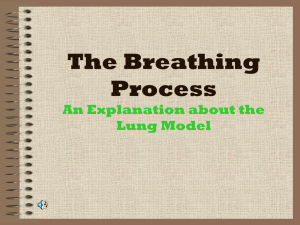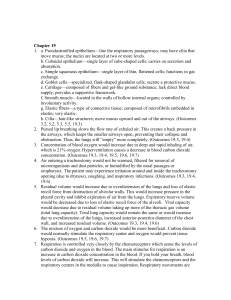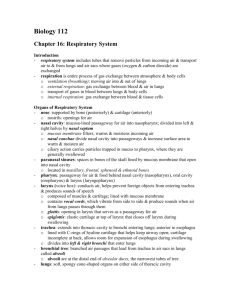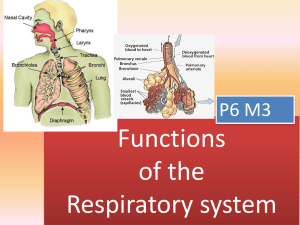File - Miss Kennedy`s Biology
advertisement
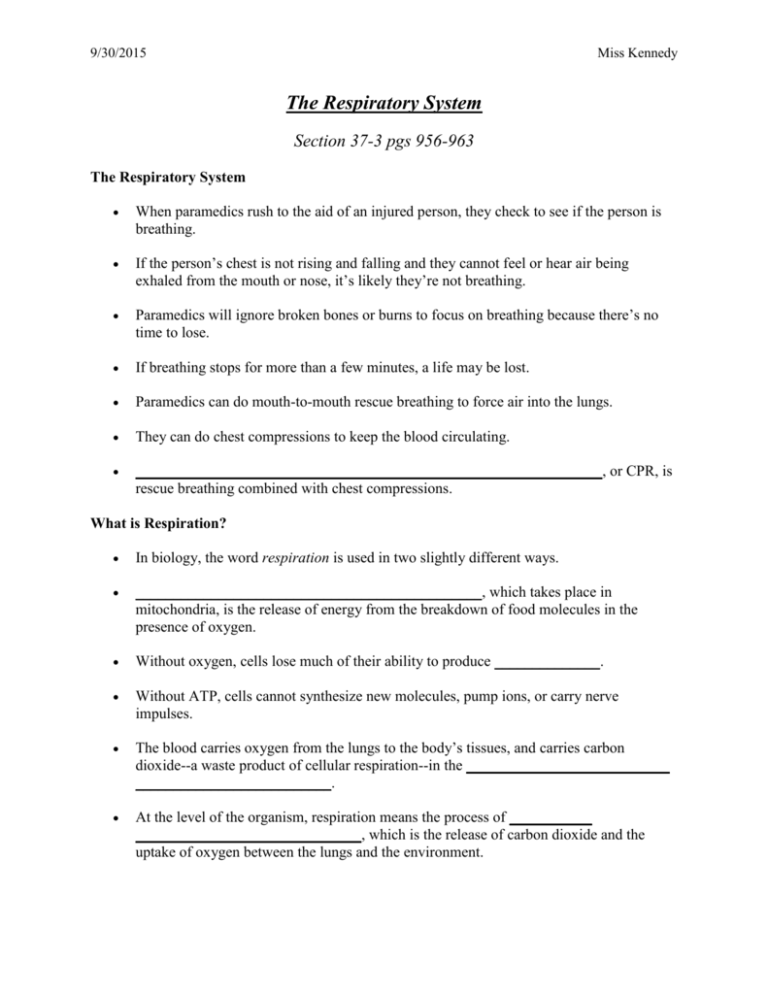
9/30/2015 Miss Kennedy The Respiratory System Section 37-3 pgs 956-963 The Respiratory System When paramedics rush to the aid of an injured person, they check to see if the person is breathing. If the person’s chest is not rising and falling and they cannot feel or hear air being exhaled from the mouth or nose, it’s likely they’re not breathing. Paramedics will ignore broken bones or burns to focus on breathing because there’s no time to lose. If breathing stops for more than a few minutes, a life may be lost. Paramedics can do mouth-to-mouth rescue breathing to force air into the lungs. They can do chest compressions to keep the blood circulating. ______________________________________________________________, or CPR, is rescue breathing combined with chest compressions. What is Respiration? In biology, the word respiration is used in two slightly different ways. ______________________________________________, which takes place in mitochondria, is the release of energy from the breakdown of food molecules in the presence of oxygen. Without oxygen, cells lose much of their ability to produce ______________. Without ATP, cells cannot synthesize new molecules, pump ions, or carry nerve impulses. The blood carries oxygen from the lungs to the body’s tissues, and carries carbon dioxide--a waste product of cellular respiration--in the ___________________________ __________________________. At the level of the organism, respiration means the process of ___________ ______________________________, which is the release of carbon dioxide and the uptake of oxygen between the lungs and the environment. 9/30/2015 Miss Kennedy The Human Respiratory System The basic function performed by the human respiratory system is remarkably simple: to bring about the exchange of oxygen and carbon dioxide between the ________________ _________________________________________. With each breath, air enters the body through the air passageways and fills the lungs, where gas exchange takes place. The respiratory system consists of _____________________, pharynx, larynx, ____________________________, bronchi, and lungs. Air moves through the nose to a tube at the back of the mouth called the _____________________________, or throat. The pharynx serves as a passageway for both air and food. Air moves from the pharynx into the _______________________, or windpipe. A flap of tissue called the _____________________________________ covers the entrance to the trachea when you swallow. The respiratory passageways allow air to pass directly into some of the most delicate tissues in the body. To keep the lung tissue healthy, air entering the respiratory system must be warmed, moistened, and filtered. Large dust particles get trapped by the hairs lining the entrance to the nasal cavity. Some of the cells that line the respiratory system produce a thin layer of _____________________. The mucus moistens the air and traps inhaled particles of dust or smoke. _____________________ sweep the trapped particles and mucus away from the lungs toward the pharynx. The mucus and trapped particles are either swallowed or spit out. These protective measures help keep the lungs clean and open for the important work of gas exchange. At the top of the trachea is the _______________________. 9/30/2015 Miss Kennedy The larynx contains two highly elastic folds of tissue known as the _________________ ____________________. When muscles pull the vocal cords together, the air between them causes the cords to vibrate and produce sounds. Your ability to speak, shout, and sing comes from these tissues. From the larynx, air passes through the trachea into two large passageways in the chest cavity called _________________________. Each bronchus leads into one of the lungs. Within each lung, the large bronchus subdivides into smaller bronchi, which lead to even smaller passageways called _____________________________________. Air moving along this path can be compared to going from an 8-lane freeway, to 4-lane freeway, to a 2-lane road, to a narrow country lane. The bronchi and bronchioles are surrounded by smooth muscle that helps to support them and enables the autonomic nervous system to regulate the size of the air passageways. The bronchioles continue to subdivide until they reach a series of dead ends, which are millions of tiny air sacs called ________________________. Alveoli are grouped in little clusters, like bunches of grapes. A delicate network of capillaries surrounds each alveolus. Gas Exchange There are about _________________________ alveoli in each healthy lung, providing an enormous surface area for gas exchange. Oxygen dissolves in the moisture on the inner surface of the alveoli and then diffuses in the opposite direction, across the membrane of the alveolus and into the air within it. The process of gas exchange in the lungs is very efficient. The air that you inhale usually contains _______________________________ and 0.04% carbon dioxide. Exhaled air usually contains less than 15% oxygen and 4% carbon dioxide. 9/30/2015 Miss Kennedy The lungs remove about ____________________________________ in the air that you inhale and increase the carbon dioxide content of that air by a _____________________ ____________. Because oxygen ____________________________________, you may wonder why hemoglobin, the oxygen-carrying protein in the blood, is needed at all. The reason is efficiency. Hemoglobin binds with so much oxygen that it increases the oxygen-carrying capacity of the blood more than ______________________. Without hemoglobin to carry the oxygen that it uses, your body might need as much as ______________ liters to get the same result. Breathing Breathing is the movement of air into and out of the lungs. Surprisingly, there are no muscles connected to the lungs. The force that drives air into the lungs comes from ordinary _____________ __________________________________. How does the body use this force to inflate the lungs? The lungs are sealed in two sacs, called the _______________________ _________________________________________ inside the chest cavity. At the bottom of the cavity is a large, flat muscle known as the ________________________________. When you breathe in, or inhale, the diaphragm contracts and rib cage rises up. This expands the volume of the chest cavity. Because the chest cavity is tightly sealed, this creates a _____________________ ____________________________ inside the cavity. Atmospheric pressure does the rest, filling the lungs as air rushes into the breathing passages. Most of the time, breathing is a ____________________________________. When the rib cage lowers and the diaphragm muscle relaxes, the pressure in the chest cavity becomes greater than atmospheric pressure. 9/30/2015 Miss Kennedy Air rushes back out of the lungs. To blow out a candle, you need a greater force. Muscles surrounding the chest cavity provide that extra force, contracting vigorously just as the diaphragm ____________________________. The system only works because the chest cavity is _________________________. A puncture wound to the chest, even if it does not affect the lungs directly, may allow air to leak into the chest cavity and make breathing impossible. This is one of the reasons chest wounds are always serious. How Breathing is Controlled You can control your breathing almost any time you want, whether it’s to blow up a balloon or to play a musical instrument. This doesn’t mean that breathing is purely voluntary. If you hold your breath for a minute or so, you’ll see what happens. Your chest begins to feel tight, your throat begins to burn, and the muscles in your mouth and throat struggle to keep from breathing. Eventually, you body takes over, forcing you to breathe. Breathing is such an important function that your __________________ ___________________________________ will not let you have complete control over it. The part of the brain that controls breathing is the ___________________________ ________________________________________. Autonomic nerves from the medulla oblongata to the diaphragm and chest muscles produce the cycles of contraction that bring air into the lungs. Cells in the medulla oblongata’s breathing center monitor the amount of _______________________________________________ in the blood. As the carbon dioxide level rises, nerve impulses from the breathing center cause the diaphragm to contract, bringing air into the lungs. The higher the carbon dioxide level, the stronger the impulses. 9/30/2015 Miss Kennedy If the carbon dioxide level reaches a _________________________________________, the impulses become so powerful that you cannot keep from breathing. That the breathing center responds primarily to carbon dioxide can have dangerous consequences. Consider a plane flying at high altitude. Although the amount of oxygen in the air decreases as the altitude increases, the passengers don’t need oxygen masks because the cabin is ________________________________________. Oxygen is available for use in an emergency, but the passengers often have to be told to begin breathing the oxygen. Although their bodies may be starving for oxygen, they have no more carbon dioxide in their blood than usual, so the breathing center does not sense a problem. Tobacco and the Respiratory System The upper part of the respiratory system is generally able to filter out dust and foreign particles that could damage the lungs. Millions of people engage in smoking ___________________________, which damages and eventually destroys this protective system. Tobacco smoke contains substances that affect the body. Three of the most dangerous substances are nicotine, carbon monoxide, and tar. ________________________________ is a stimulant drug that increases heart rate and blood pressure. ________________________________________________________ is a poisonous gas that blocks the transport of oxygen by hemoglobin in the blood. It decreases the blood’s ability to supply oxygen to its tissues, depriving the heart and other organs of the oxygen they need to function. ________________ contains a number of compounds that have been shown to cause cancer. Smoking tobacco brings nicotine and carbon monoxide into the upper respiratory system. These compounds _________________________________________________. 9/30/2015 Miss Kennedy With the cilia out of action, the inhaled particles stick to the walls of the respiratory tract or enter the lungs. Without cilia to sweep it along, smoke-laden mucus becomes trapped along the airways. This explains why smokers often cough. Irritation from the accumulated mucus triggers a cough that helps to ________________ ___________________________________________. Smoking also causes the lining of the respiratory tract to swell, which reduces the air flow to the alveoli. Only __________________________ of male smokers live to age 80, where 55 percent of male non-smokers live to that age. Clearly, smoking reduces _______________________________________________. Smoking can cause such respiratory diseases as _________________________ ______________________________________, emphysema, and lung cancer. In chronic bronchitis, the bronchi become swollen and clogged with mucus. Even smoking a moderate number of cigarettes on a regular basis can produce chronic bronchitis. Affected people often find simple activities, such as climbing stairs, difficult. Long term smoking can also cause a respiratory disease called ___________________________________________. Emphysema is the ______________________________________________________ _________________________ of the lungs. This condition makes breathing very difficult. People who have emphysema cannot get enough oxygen to the body tissues or rid the body of excess carbon dioxide. Smoking is an important, but preventable, cause of lung cancer. __________________________________________ is particularly deadly because its cells can spread to other locations. By the time lung cancer is detected, it usually has spread to dozens of other places. 9/30/2015 Miss Kennedy About ________________________________ people in the United States are diagnosed with lung cancer each year. Few will survive for five years after the diagnosis. Smoking is also a major cause of ____________________________________. Smoking constricts, or narrows, the blood vessels, which causes ____________________ ________________________________________ and makes the heart work harder. There is a drastic change in body temperature and in circulation immediately after smoking a cigarette. Smoking doubles the risk of death from heart disease for men between 45 and 65. The risk of death from heart disease for all ages is greater among smokers than among non-smokers. In recent years, evidence has shown that tobacco smoke is damaging anyone who inhales it, not just the smoker. For this reason, many states have restricted smoking in restaurants and other public places. ____________________________________________, or inhaling the smoke of others, is particularly damaging to young children because their lungs are still developing. Studies now indicate that the children of smokers are twice as likely as children of nonsmokers to develop respiratory problems, such as _________________________. Whatever the age of a smoker, and no matter how long that person has smoked, his or her health can be improved by quitting. Nicotine is a powerful drug with strong __________________________ _________________________________ that make it very difficult to quit smoking. Thus, considering the cost, the medical dangers, and the powerful addiction, the best solution is to _____________________________________________________.



